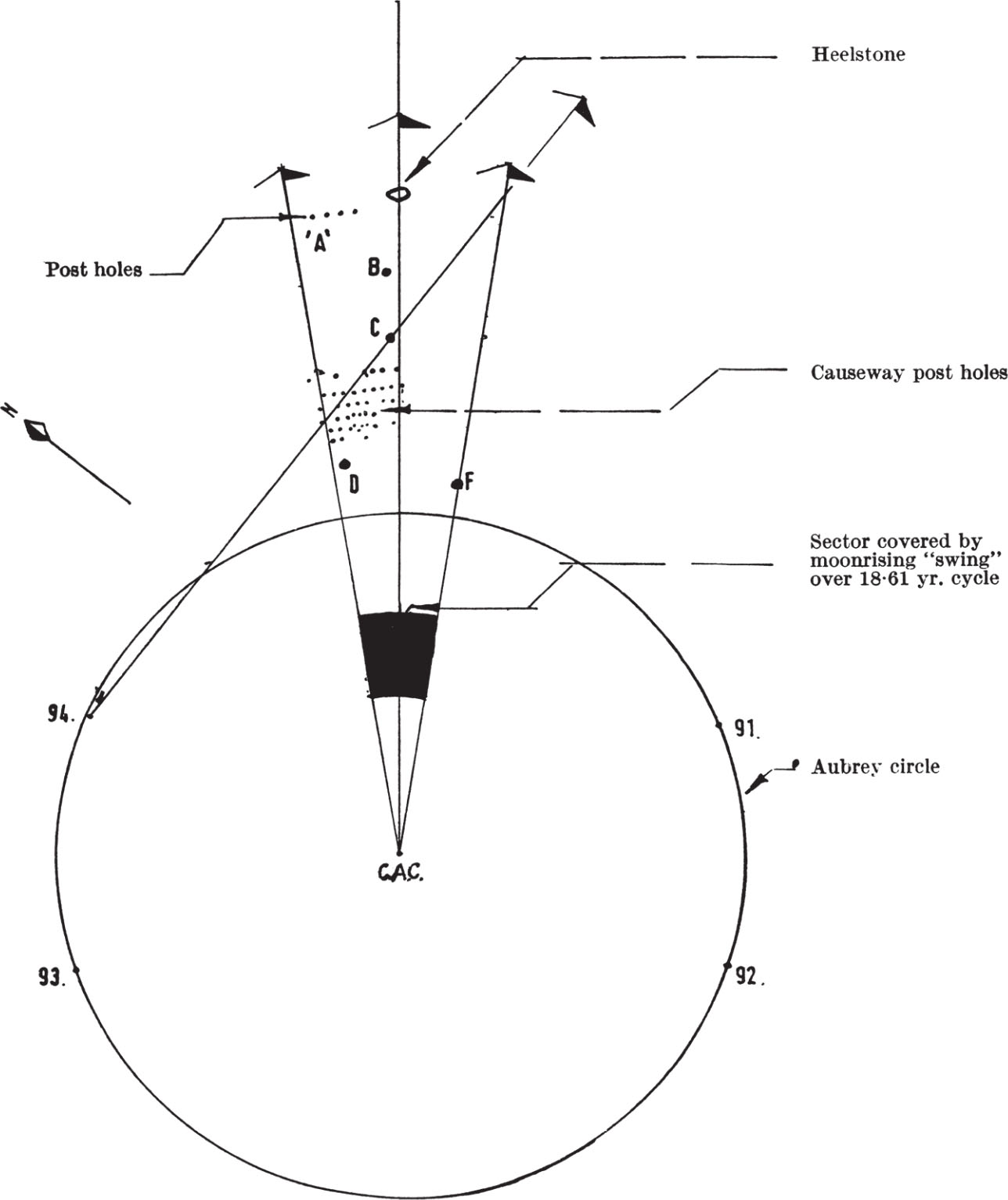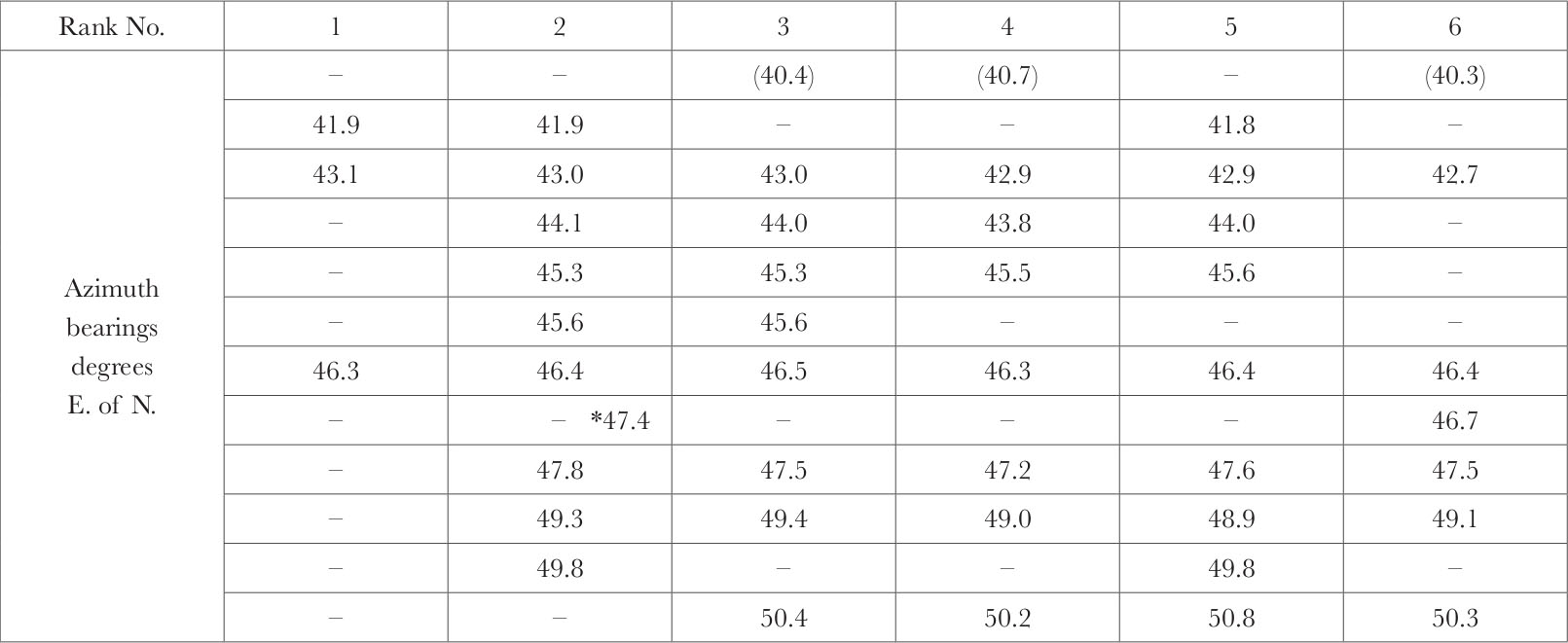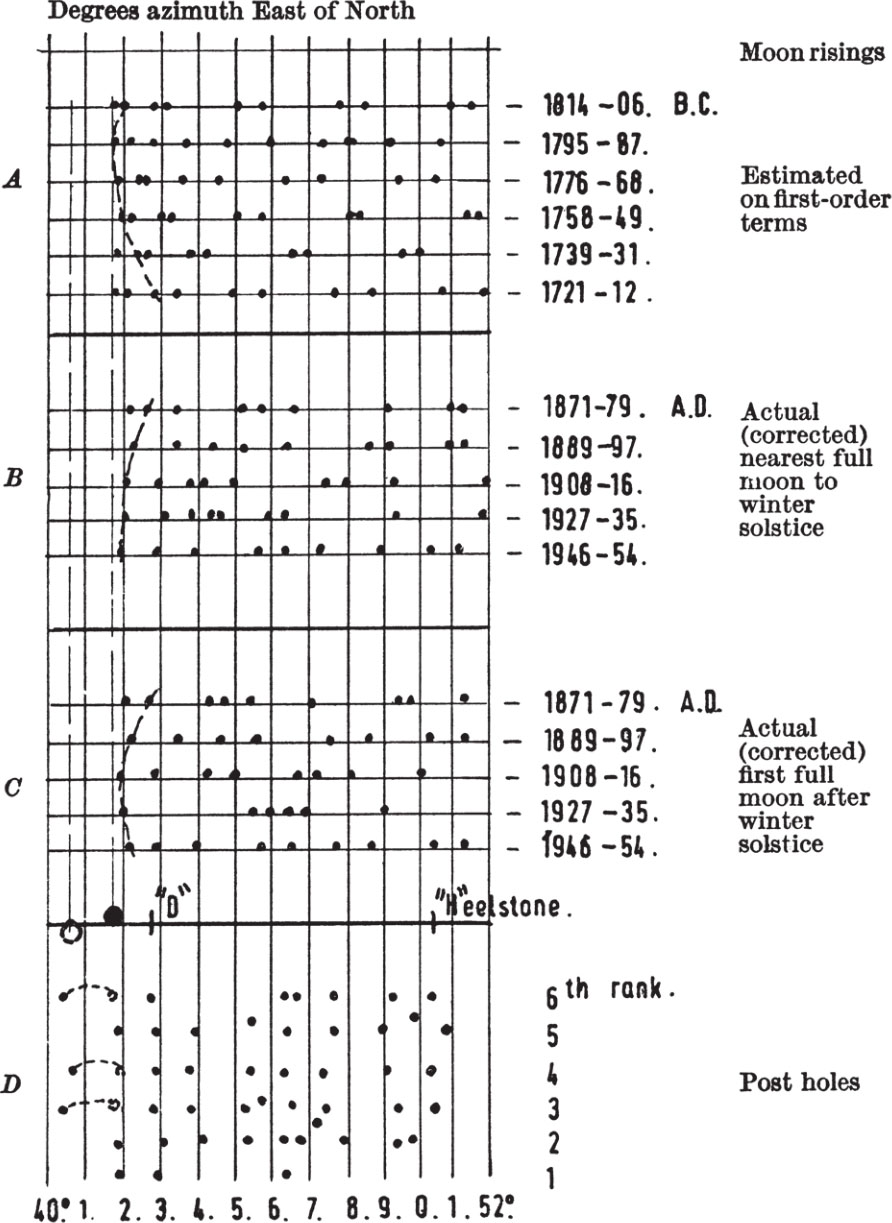




 Stonehenge—A Neolithic “Observatory”
Stonehenge—A Neolithic “Observatory”
C. A. Newham
Editor’s Note
The astronomical function of the ancient monument of Stonehenge near Salisbury in England is also considered in this contribution by astronomer C. A. (“Peter”) Newham. He proposes that the post holes of the stone circle were used to mark the bearing of moonrise, which would be used to help predict eclipses. Archaeologists, however, have remained somewhat sceptical of such speculative interpretations by astronomers. 中文
PROF. G. S. Hawkins 1 has shown how Stonehenge could be regarded as a “computer” to predict the time when eclipses of the Sun and Moon were due, though not always visible at Stonehenge. He ingeniously relates the fifty-six Aubrey holes with a 56-year eclipse cycle. The principle is valid, but there is no evidence to support the idea that Stonehenge was intended to be a “computer” other than that the majority of main features embodied in the “monument” unquestionably have some astronomical connexion. There are, however, a number of “post holes”; however, no satisfactory explanation has so far been put forward to explain their purpose. 中文
An analysis of the position and number of post holes prompts a suggestion as to their purpose, and may well provide the clue to the method by which the builders of Stonehenge acquired elementary knowledge of Moon cycles, possibly including the approximate 56-year eclipse cycle. 中文
Stonehenge post holes . Of the many post holes found in and around Stonehenge, there is one group of about forty holes situated in the “causeway” near the northeast entrance (Fig. 1). The holes seem to radiate from the centre of the Aubrey circle, and lie within a 10-degree arc north of the heelstone or solstice line. They are roughly arranged into six ranks crossing the line of the causeway. 中文

Fig. 1. Schematic diagram showing the position of post holes in relation to other main features
A fairly reliable record of the behaviour of the Moon could be obtained by planting a temporary marker (wooden stake) to align on the point where the winter full-moon appeared above the horizon each year. The indications are such that this was done over a large number of years covering several 18.61-year cycles. Such a period would be sufficient to ascertain a 19-year phase or metonic cycle and possibly the approximate 56-year eclipse cycle as suggested by Hawkins (that is, 3×18.61=55.83). It should be appreciated, however, that they would have considerable difficulty in defining this eclipse cycle by their crude methods. 中文
Starting from the premise that the post holes were used for the purpose suggested, the azimuth bearing of each post hole was first ascertained in rank order, numbered 1 to 6 counting in a north-easterly direction. 中文
The number of holes attributed to each rank and their azimuth bearings taken from the centre of the Aubrey circle are given in Table 1. 中文
Table 1

The figures in parentheses refer to holes beyond the line of full orb but are reached by the line of first gleam of moonrise.
* This hole is situated between ranks No. 2 and No. 3 and cannot be allocated to either rank. 中文
Preliminary calculations reveal that the causeway post holes lie within the arc or sector of the most northerly limits of winter full-moon rise as seen from the centre of the Aubrey circle (C.A.C.); also, the number of holes in any one rank did not exceed the number of risings that could appear north of the heelstone or solstice line in any one cycle. 中文
If individual bearings of moonrise in a sequence of cycles were found to agree with the “hole alignments”, any doubt as to their significance would be eliminated; furthermore, dating of the post holes would be feasible. Unfortunately, the necessary data concerning the Moon are not available; to obtain such information would severely tax the ability of the most expert celestial mechanician. 中文
However, computed moonrise bearings covering the period of 2000–1000 B.C. were first used in an attempt to determine whether any similarity existed between general grouping of the post holes and a sequence of moonrisings. The data used were kindly supplied by Prof. G. S. Hawkins. His calculations are based on first-order terms and refer to the full-moon nearest the winter solstice and also require that the instant of moonrise should coincide with the time when the Moon reaches its appropriate maximum declination. This particular feature seldom applies (see Fig. 2). 中文

Fig. 2. Comparable azimuth bearings of winter full-moon risings (Full-orb tangent to horizon) and post hole alignments
Group “ A ”: Six cycles of moonrisings based on first-order terms as supplied by Hawkins for period 1814–1712 B.C.
Group “ B ”: Similar to “ A ” but the “Moons” correspond to the known rising position covering the period A.D. 1871–1954 after correction to allow for the change in the angle to the ecliptic of the Earth–Moon system over the past 3,800 years
Group “ C ”: Basically similar to “ B ”, but here it applies to the first full-moon after the winter solstice
Group “ D ”: Depicts the post holes arranged according to their azimuth bearings
The data connected by broken lines are all separated by a period of 6,940 days or exactly 19 years within a few hours, and differ from other similar Moons in that their rising positions are practically the same. The broken lines in group “ D ” merely indicate the position the three holes would occupy if they were aligned on full orb. The two larger circles immediately above represent the most northerly position of first gleam and full orb of moonrise. The positions of stone “ D ” and the heelstone are indicated on the same line 中文
The pattern of risings that would apply to the early Stonehenge period is more truly represented in groups “ B ” and “ C ”. Even so, their arrangements could be subject to slight variations as many individual moons have possible alternative rising positions. This applies in those cases when the Moon reaches “full” during the daytime, for example, on December 12, 1875, the Moon was full at 0745 h (shortly before setting). In similar circumstances, would they regard the critical Moon as being that which rose on the afternoon of December 12, or that of the following day? If midnight was their datum, the former Moon would apply. On the other hand, it would be the latter if the critical time was on its rising. A similar condition arises in respect of those Moons which are full 14 or 15 days before the solstice and would be followed by the next Moon 14 or 15 days after the solstice. 中文
There is no question that people of early civilizations had to contend with the same difficulty which was partly obviated by choosing the critical Moon as the one which was full after a specified time, such as the day of the winter solstice or equinox. In the second millennium B.C. the Delians regarded the critical Moon as the first one that was full after the winter solstice, and the possibility that such was the case with the Stonehenge people cannot be overlooked. However, the remarkably close relationship of the moonrise sequences and hole patterns must surely be more than a coincidence. If this suggested method of observation had been carried out by the Stonehenge people, they would have had little difficulty in recognizing the 19-year phase or metonic cycle. 中文
It seems fair to assume that these and other post holes served a purpose in obtaining preliminary information of the behaviour of the Sun and Moon. Once satisfactory alignments had been established, markers of a more permanent kind would be installed. If the foregoing assumptions were correct, then the long period of time that elapsed between the inception of the bank, etc., and the building of the first major stone structures would be accounted for. 中文
The position and spacing of the four large post holes near the heelstone indicate a relationship with the causeway holes, especially so in conjunction with stone “ D ” and the heelstone. The size of the holes indicates that the posts were much larger than the causeway posts and, presumably, more permanent. If stone “ B ” were also included, then the seven markers which could be observed would act as a crude “vernier”. When correlated with the setting Sun seen in the reverse direction, it would provide a means of defining the time when an eclipse of the Moon was probable. 中文
Whether or not Stonehenge people discovered the 56-year cycle is a matter for conjecture, but their ability to predict pending eclipses after a crude fashion was certainly possible. 中文
It can be shown that a person assisted by nothing more than the crudest equipment in the form of a peg and line and a few stakes could acquire the necessary information. The observer, however, would have to have the necessary tenacity of purpose to undertake systematic observations over a long period of time and a simple method of recording numbers by means of tokens, for example, notches on a stick or pebbles in a bag. 中文
Doubtless, several generations of observers were involved, and if we are to believe that the writings of Diodorus referred to Stonehenge, then the position of supervisor of the “Spherical
 Temple” was held by a member of the same family from one generation to another.
中文
Temple” was held by a member of the same family from one generation to another.
中文
The strong lunar influence with which Stonehenge must now be associated necessitates revision of hitherto accepted explanations of some salient features. Until new evidence is found pointing to the contrary, it is more logical to conclude:
( a ) That the small stone (No. 11) in the sarsen circle was intentional, and that the circle represented the 29.5 days of the lunar month.
( b ) The double circle or spiral 2 of the “ Y ” and “ Z ” holes represented the 59 days of two lunar months. The strong possibility that there were fifty-nine blue stones inside the sarsen circle would provide a more suitable means of representing the same thing.
( c ) The 19-year phase or metonic cycle was represented by the nineteen blue stones inside the trilithon “horse shoe”. 中文
All things considered, including other similar post holes, there seems little doubt that Stonehenge, in its early stages, was a kind of “observatory”. It provided a suitable site wherein systematic observations of “Soluna” (Sun and Moon) phenomena were carried out by these neolithic peoples. 中文
( 211 , 456-458; 1966)
C. A. Newham: 5 Sedge Rise, Tadcaster, Yorkshire.
References: